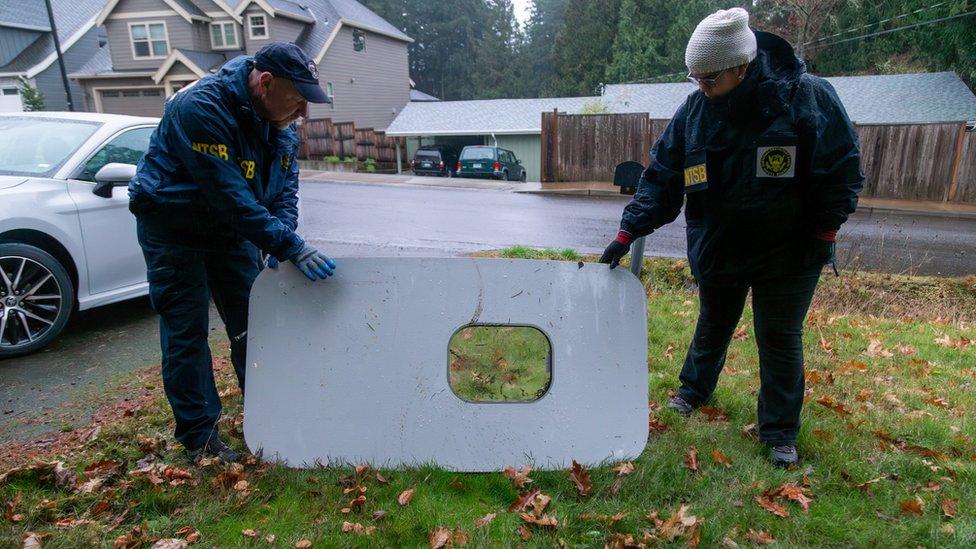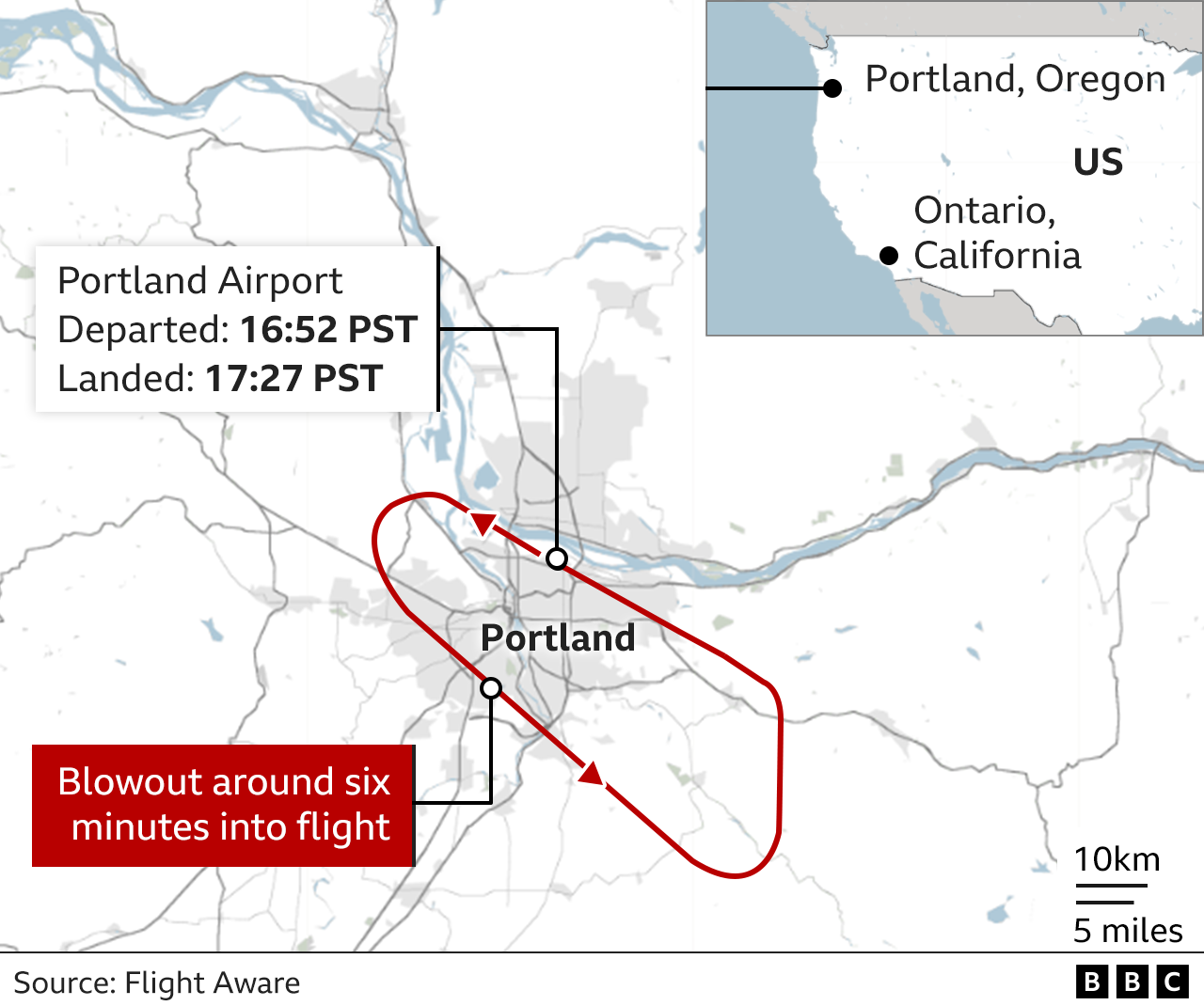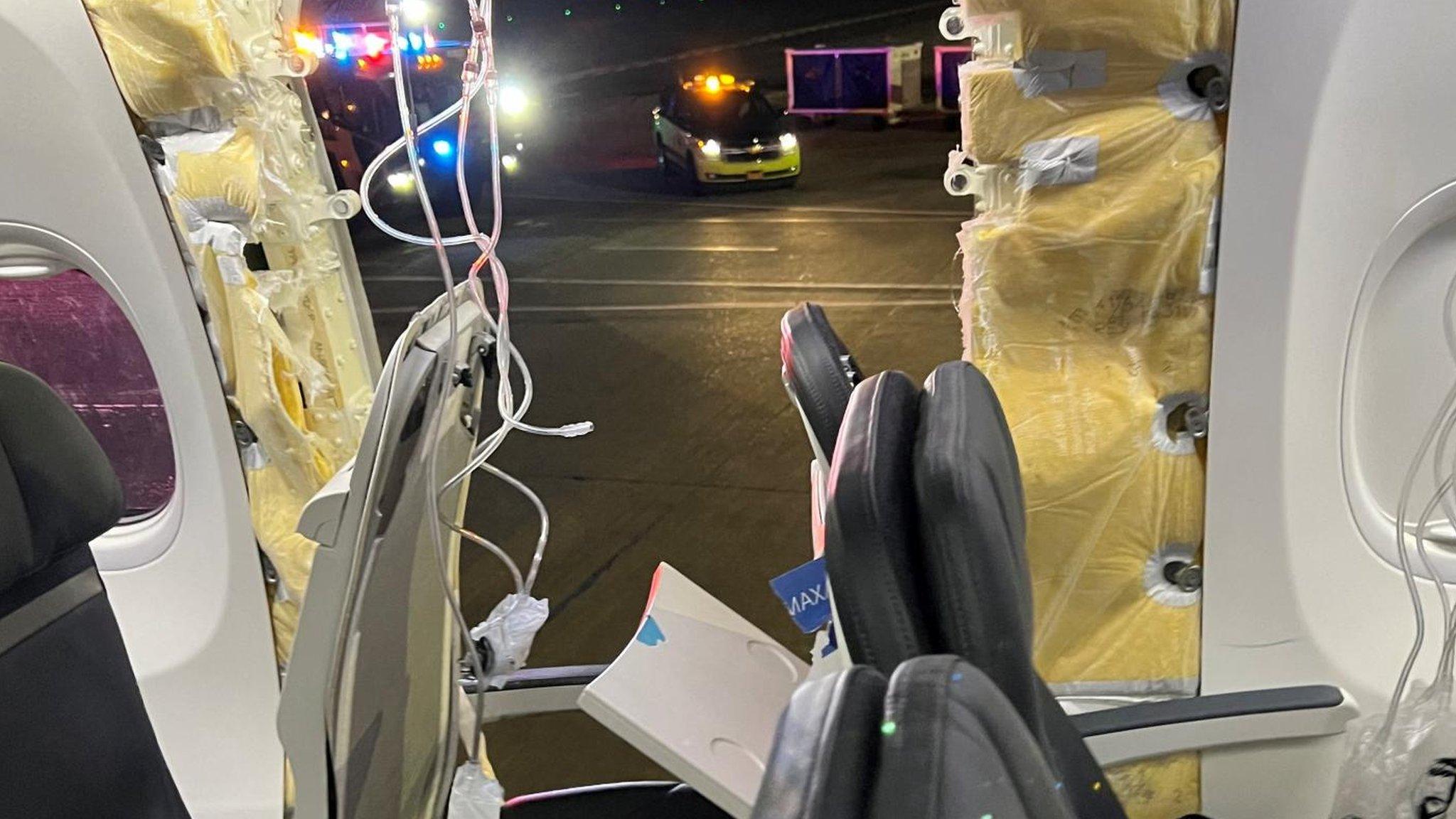Alaska Airlines plane had warnings days before mid-air blowout
- Published
Watch: 'Trip from hell': On board flight during mid-air blowout
Alaska Airlines placed restrictions on the Boeing plane involved in a dramatic mid-air blowout after pressurisation warnings in the days before Friday's incident, investigators say.
The jet had been prevented from making long-haul flights over water, said Jennifer Homendy of the US National Transportation Safety Board (NTSB).
The NTSB also says the missing section of plane has now been found - in the back garden of a Portland teacher.
No-one was hurt in Friday's drama.
After losing part of its fuselage, the plane - a Boeing 737 Max 9 - made a safe emergency landing after returning to its departure city, Portland.
There were 177 passengers and crew on board the flight to Ontario, California.
Some 171 planes of the same type remain grounded by the US regulator, the Federal Aviation Administration (FAA), as safety checks continue.
Before Saturday's intervention by the FAA, Alaska Airlines briefly returned some of its Max 9s to service, saying it had made "no concerning findings".
Speaking at a news conference, Ms Homendy said pilots reported pressurisation warning lights on three previous flights made by the specific Alaska Airlines Max 9 involved in the incident.
The decision to restrict lengthy flights over water was so that the plane "could return very quickly to an airport" in the event the warnings happened again, the NTSB chief added.
It is not clear if there is a link between the issues that led to those warnings, and the issue that caused the blowout on 5 January.
"An additional maintenance look" was requested but "not completed" before the incident, Ms Homendy said.
The plane was brand new having been delivered to Alaska Airlines in October - at which time it was judged by the FAA to be airworthy.
Ms Homendy also used the conference to set out new details of the "very chaotic" and "terrifying" situation on board Alaska Airlines flight 1282.
The force of the blowout caused the door of the cockpit to open and a laminated checklist and the first officer's headset both flew out into the cabin, she said.
She added that no information from the cockpit voice recorder was available, as the recording had been automatically wiped after a two-hour cut-off was reached.
The NTSB wanted this window to be increased to 25 hours, she added.
Ms Homendy later announced that the part of the fuselage that detached had been found, after a teacher named Bob located the missing section in his backyard.
"I'm excited to announce that we've found the door plug," she told reporters. "Thank you, Bob."
The plug is a piece of fuselage weighing 27kg (60lb), with a window, that can be used as an emergency exit in certain configurations. Authorities had been searching for it in Portland, the departure city.
Ms Homedy said it was the "key missing component" to work out why the blowout happened.
Two mobile phones believed to have fallen from the aircraft are also reported to have been found.
An Oregon man shared an image of an iPhone which he said he had discovered, external, working as normal, in a grass verge beside a road. The device appeared to display an email receipt for a $70 (£55) checked baggage charge for the flight.

Agents from the National Transportation Safety Board have recovered the plane's door plug
Flight 1282 reached 16,000ft (4.8km) when it began its emergency descent on Friday evening, according to flight tracking data.
Images shared online - and later by investigators - showed a wide hole in the side of the craft, with oxygen masks dangling from the ceiling.
One passenger, Diego Murillo, said the gap left by the missing component was "as wide as a refrigerator".
Passengers were quoted by The Oregonian newspaper as saying that a young boy seated near the affected area had his shirt ripped off by the force of the decompression.
Alaska Airlines said in its most recent statement: "While we await the airworthiness directive (AD) inspection criteria from the FAA and Boeing, our maintenance teams are prepared and ready to perform the required inspections of the mid exit door plugs on our 737-9 Max fleet.
"The 737-9 Max grounding has significantly impacted our operation. We have cancelled 170 Sunday flights and 60 cancellations for Monday, with more expected."
Boeing said in a statement: "Safety is our top priority and we deeply regret the impact this event has had on our customers and their passengers."
Listen: Alaska flight's distress call to air traffic control
The company's 737 Max has been described as "the most scrutinised transport aircraft in history" after a series of safety issues.
In late 2018 and early 2019, two of its aircraft were lost in near identical incidents, off the coast of Indonesia and outside the Ethiopian capital Addis Ababa.
A total of 346 people were killed. Both crashes were caused by flawed flight control software, which ultimately forced the planes into catastrophic dives, despite the best efforts of the pilots.
After Friday's incident in the US, the European Union's regulator followed the example of its US counterpart. But it expected disruption to be minimal as it believed no European airlines used Max 9s with the configuration covered by the FAA order.
Icelandair said it was not affected. The real-time flight-tracking website Flightradar24 confirmed that a number of the airline's Max 9s were in the skies on Monday morning.
The bulk of the affected planes are operated by US operators - 79 of them by United Airlines and 65 by Alaska - which has meant disruption for thousands of passengers.

- Published8 January 2024

- Published8 January 2024

- Published8 January 2024

- Published7 January 2024

- Published7 January 2024

- Published6 January 2024
